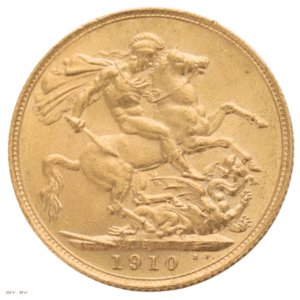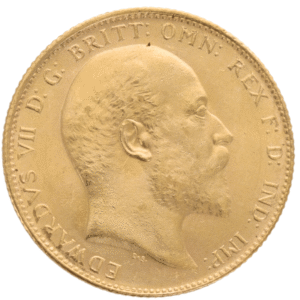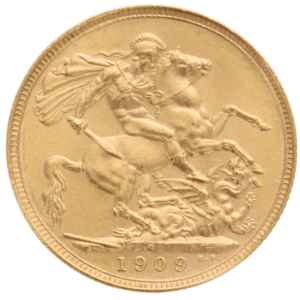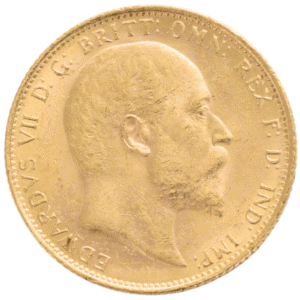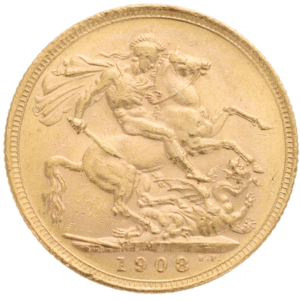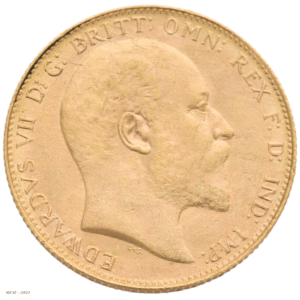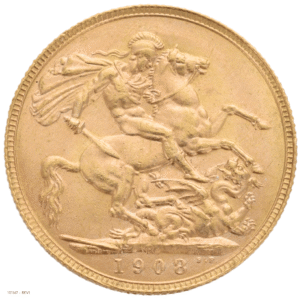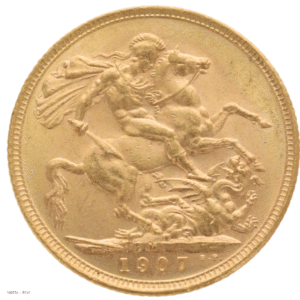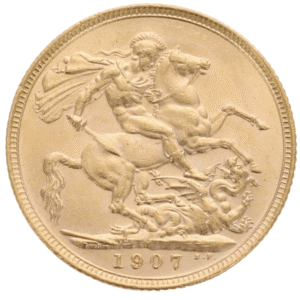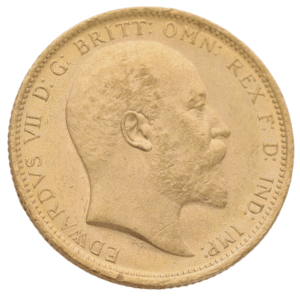The King Edward VII sovereign represents an important transitional period in British numismatic history. Minted from 1902 to 1910, these distinguished gold coins bridge the Victorian era and the modern age, carrying both historical significance and enduring value for collectors and investors alike.
Following Queen Victoria’s death in January 1901, her son Albert Edward ascended to the throne as King Edward VII at the age of 59. Having served as Prince of Wales for nearly six decades—the longest tenure in that role in British history—Edward’s reign, though brief (1901-1910), marked the beginning of the Edwardian period, characterised by relative peace and prosperity before the upheaval of World War I.
The sovereign’s design underwent significant changes to reflect the new monarch:
The obverse features a dignified bare head portrait of King Edward VII facing right, designed by George William De Saulles, whose initials “DeS” appear in relief on the bust truncation. This portrait restored the tradition of monarchs facing in the opposite direction from their predecessor, as Edward faces right while Victoria faced left on her coinage.
The reverse maintained Benedetto Pistrucci’s classic St. George slaying the dragon design, first introduced in 1817. Two reverse varieties exist: the first type (1902-1904) has no designer’s initials, while the second type (1904-1910) includes the engraver’s initials “B.P.” in the exergue below the main design.
Edward VII sovereigns were produced at multiple mints across the British Empire:
- London (no mint mark): The primary production facility with substantial annual mintages
- Sydney (S mint mark): Continuing Australia’s sovereign tradition
- Melbourne (M mint mark): Another significant Australian producer
- Perth (P mint mark): The newest Australian mint during Edward’s reign
- Ottawa, Canada (C mint mark): Limited production from 1908-1910
These coins circulated during a pivotal historical period. The Edwardian era witnessed significant technological advancements, including the development of the automobile, early aviation, and radio communication. The period also saw increasing tensions between European powers that would eventually lead to World War I.
FAQs
King Edward Sovereigns are British gold coins featuring the portrait of King Edward VII. They were minted during his reign, from 1902 to 1910.
King Edward VII, known for his affable personality, was the monarch who succeeded Queen Victoria and reigned from 1901 to 1910. He played a crucial role in the political landscape and international relations of his era.
Gold sovereigns have a storied history dating back to the 15th century under the reign of Henry VII. They are considered iconic and highly collectible due to their historical value and craftsmanship.
No, sovereigns circulated throughout the vast British Empire, which at its height covered approximately 24% of the Earth’s land surface. They were legal tender in countries including Australia, New Zealand, Canada, South Africa, and India. The gold standard meant these coins were accepted virtually worldwide, even in countries outside the British Empire.
Several factors determine value beyond the gold content:
- Mintage: Lower production numbers generally correlate with higher values
- Mint mark: Colonial mint coins (S, M, P, C) command significant premiums
- Condition: Uncirculated examples can bring 3-5 times the value of circulated coins
- Strike quality: Well-struck examples with full detail are more desirable
- Historical significance: First-year (1902) and final-year (1910) issues often command premiums

